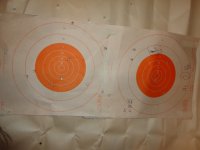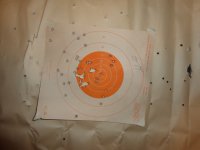"I suck "
"
Bullhockey.
You just did'nt realize what a bear a snubbie can be to shot well.
They fact you are practicing with it and adapting your shooting technique to it's characteristics means you definitely do not suck.
I own a Taurus Model 85 Ultralight that is slightly heavier then the gun you are shooting but once I got used to it,I love my little snubbie.
Five shots in a man's chest at up to ten yards.
Everytime.
Just gotta grip the crxp out of it and see that front sight.
Helps to memorize the angle of your wrist to the angle of the sights aligning and to align the sights as you draw it up too.
And lock that arm out to at the same angle everytime in a way that is natural for you to support the gun back down in recoil.
Only problem at the range for me in I find myself buying way too much 38 special reloads to have more shooting fun with.
I shoot with reduced size human shape targets.
If you are going to use the gun for self defense-you might as wel;l shoot at something with a human shape so you can get yourself used to hitting that form of target.
And I don't just shoot in the chest area either.
Good groupings in other areas can stop an assailant very quickly.
Bullhockey.
You just did'nt realize what a bear a snubbie can be to shot well.
They fact you are practicing with it and adapting your shooting technique to it's characteristics means you definitely do not suck.
I own a Taurus Model 85 Ultralight that is slightly heavier then the gun you are shooting but once I got used to it,I love my little snubbie.
Five shots in a man's chest at up to ten yards.
Everytime.
Just gotta grip the crxp out of it and see that front sight.
Helps to memorize the angle of your wrist to the angle of the sights aligning and to align the sights as you draw it up too.
And lock that arm out to at the same angle everytime in a way that is natural for you to support the gun back down in recoil.
Only problem at the range for me in I find myself buying way too much 38 special reloads to have more shooting fun with.
I shoot with reduced size human shape targets.
If you are going to use the gun for self defense-you might as wel;l shoot at something with a human shape so you can get yourself used to hitting that form of target.
And I don't just shoot in the chest area either.
Good groupings in other areas can stop an assailant very quickly.


